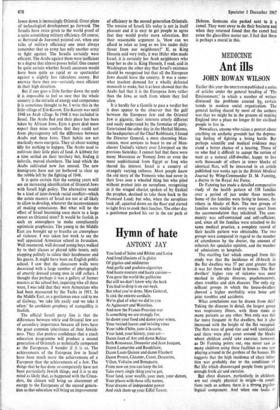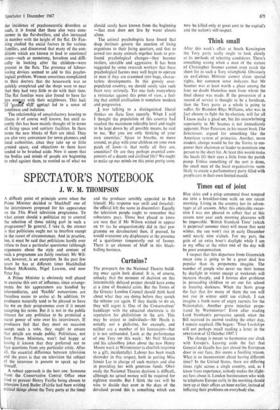Ant ills
MEDICINE JOHN ROWAN WILSON
Earlier this year the SPECTATOR published a series of articles under the general heading of 'The Environment,' in which a number of writers discussed the problems created by„ certain trends in modern social organisation. The general feeling shared by most of the authors was that we might be in the process of making England into a place no longer fit for civilised people to live in.
Nowadays, anyone who raises a protest about anything on aesthetic grounds has the depress- ing feeling of fighting a losing battle. But perhaps scientific and medical evidence may stand a better chance of a hearing. Those of us who find it difficult to accept the notion of man as a natural cliff-dweller, happy to live with thousands of others in tower blocks of identical flats, will be interested in an article published two weeks ago in the British Medical Journal by Wing-Commander D. M. Fanning, a doctor in the Royal Air Force.
Dr Fanning has made a detailed comparative • study of the health pattern of 558 families over a period of just under three months. Some of the families were living in houses, the others in blocks of. flats. The two groups of families were similarIn every way apart from the accommodation they inhabited. The com- munity was self-contained and self-sufficient, and, since all the families were attached to the same medical practice, a complete record of their- health pattern was obtainable. The two groups were compared in regard to the number of attendances by the doctor, the amount of referrals for specialist opinion, and the 'number of admissions to hospitals.
The startling fact which emerged from this study was that the incidence of ill-heath in the flat dwellers was 57 per cent greater than it was for those who lived in houses. The flat- dwellers' higher rate of sickness was most marked in allergic diseases, psychoneurosis, chest troubles and skin diseases. The only sig- nificant groups in which the house-thVellers showed a. higher morbidity were bone and joint troubles and accidents.
What conclusions can be drawn from this? Taking the diseases in detail, the largest group was respiratory illness, with three times as many patients as any other. Not only was this far more frequent in flat dwellers, but it also increased with the height of the flat occupied. The flats were of good size .and well ventilated, and there were play areas around the blocks where children could take exercise; however, as Dr Fanning points out, one never saw as many children using these facilities as one saw playing around in the gardens of the houses. He suggests that the high incidence of chest infec- tion was probably due to the- conditions of flat life which discouraged people from getting enough fresh air and exercise.
But chest diseases, particularly in children, are not simply physical in origin—in condi- tions such as asthma there is a strimig..psycho- logical component. And when one looks at the incidence of psychoneurotic disorders as such, it is found that these also were com- moner in the flat-dwellers, and also increased in number with the height of the flat. Dr Fan- ning studied the social factors in the various families, and discovered that many of the con- ditions which are known to lead to emotional stress—such as monotony, boredom and diffi- culty in looking after the children—were present in the flats. The presence of labour- saving devices seemed to add to this psycho- logical problem. Women sometimes complained. to their doctors that the housework _was so quickly completed and the shops were so near that they had very little to do with their time. The flat families were also found to have far less coniact with their neighbours. This lack
of rgardet ' contact led to a sense of loneliness and isolation.
The relationship of unsatisfactory housing to illness is of course well known, but until re- cently this has been mainly thought of in terms of living space and sanitary facilities. In these terms the new blocks of flats are ideal. They are also very convenient for town planners and local authorities, since they take up so little ground space, and objections to them have tended to be brushed aside. Now it seems that the bodies and minds of people are beginning to rebel against them, to remind us of what we
should surely have known from the beginning —that man does not live by water closets alone.
The animal psychologists have found that deep instincts govern the reaction of living organisms to their living quarters, and that to crowd too many animals together leads to pro- found psychological changes—they become restless, unstable and aggressive. It has been suggested by some research workers that these psychological factors may well begin to operate in man if they are crammed into huge, charac- terless developments. In this grossly over- populated country, we should surely take such fears very seriously. Yet one feels everywhere a resistance against this point of view, a feel- ing that anthill civilisation is somehow modern and progressive.
was talking to a distinguished liberal thinker on these- lines recently. When_ I said I thought the population of this country had reached the maximum tolerable level and ought to be kept down by all possible means, he said to me, 'But you are only thinking of your own amenities.' Space to breathe, to move around, to play with your children on your own patch of lawn—is that really all they are, amenities? Or are they perhaps essential com- ponents of a decent and civilised life? We ought to make up our minds on this point pretty soon.



































 Previous page
Previous page